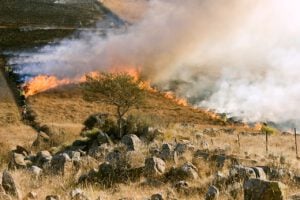
Conservationists are all facing very challenging times. And arguably the biggest challenge is posed by the evolution of what is arguably now the costliest destructive force facing America; ‘catastrophic wildfire‘.
Q2 2020 hedge fund letters, conferences and more
In 2017, in California alone, catastrophic wildfires caused $180-billion in total losses! https://www.courthousenews.com/costs-to-fight-2017-california-wildfires-shatters-records/
California wildfires of 2020 have already caused untold losses and the season isn’t even over yet.
However, the financial impact of catastrophic wildfires extents far deeper and longer-term into the the fabric of the American economy, affecting timber, fisheries, recreational sports (fishing, hunting, hiking, etc.) and agriculture, being the biggest losers.
And this is all due to flawed obsolete natural resource management policies that are guided by misinformed and wrongheaded people, some of whom are so-called ‘scientists’.
That said, the heaviest financial impact from catastrophic wildfire may still yet be brewing. The healthcare impacts stemming from human exposures to toxic wildfire smoke is just beginning to be understood, and is arguably already costing hundreds of millions of dollars by itself annually.
Economic Impact: What Makes Wildfire ‘Catastrophic’?
Catastrophic wildfire is abnormal on the landscape and is due to abnormally high temperatures (approaching 1,800 degrees F), which results from the combustion of prodigious fuel loading (primarily grass and brush), that as settled science proves, results from a decline in large herbviores (deer, wild horses, elk, bison) on the landscape. ‘Ripple, William J’ et. al.
These now ginormous wildfires are approaching one-million acres in size, eclipsing the 100k acre, ‘mega-fire’.
The post wildfire devastation is now in many cases as bad as the initial death and destruction from these new-breed wildfires, which are for the first time destroying entire forests of fire-evolved trees (conifers)!
The aftermath of these abnormally hot catastrophic wildfires includes, but is not limited to; the loss of micro-biomes in soils (pasteurization), loss of soils stability (loss of root systems), permanent chemical alteration of soils. The results of soils instabilities and chemical alterations via abnormally hot wildfires are devastating to the flora and fauna as well as to the streams and rivers. The abnormal erosive runoff post-wildfire results in extreme silting-in of the spawning grounds just prior-to and during the fall, winter and spring-run salmon and steelhead runs.
Watersheds are devastated by unnatural erosion which further destabilizes slopes and ensures further abnormal erosion in future seasons.
Of course, without the appropriate density and diversity of vegetation on the landscape, aquifers are not properly refreshed leading to further depletion of water that is vital to any watershed.
Topping this all off is the excess release of greenhouse gases from catastrophic level wildfires, which exacerbates climate change, at the worst possible time.
Re-balancing and maintaining our ecosystems via the reestablishment of the appropriate population density and diversity of large herbivores, especially wild horses, is based on sound science. In many areas a paleo-ecological perspective might provide a solid baseline starting point, which contains an undisputed record of the landscape (just a few thousand years ago) prior to the anthropogenic disruptions on the landscape.
Choosing The Right Large Herbivore Is Critical When Grazing Wilderness Areas:
By comparing and contrasting the following two studies, we quickly learn (and see from photos) why cattle and sheep cannot be used in remote wilderness areas, critical watershed areas, and or areas that contain threatened or endangered flora.
1) Project To Reform Public Land Grazing In Northern California: https://wildcalifornia.org/wp-content/uploads/2016/01/Annual-Report_2015_final-final.pdf
And then;
2) ‘Impact Of Wild Horses On Wilderness Landscape And Wildfire’ (Published in two online journals)
a) Pitchstone Waters: https://pitchstonewaters.com/wild-horse-fire-brigade-lessons-in-rebalancing-north-american-ecosystems-by-rewilding-equids/
b) GrazeLIFE: https://grazelife.com/blog/wild-horse-fire-brigade-lessons-in-rebalancing-north-american-ecosystems-by-rewilding-equids/
Herbivores with multiple stomachs (cows, sheep, etc.) are complex digestors and such digestive processes kills virtually every seed they eat. The opposite is true for equids, which have a single stomach and pass most of the seeds they eat back onto the ground with humus and ready to grow.
Note: The author is currently reseeding his own lands by feeding local wild horses the seeds he wants distributed across his private landscape. As of this article, the author already has oat-grass growing wild in many areas where it was never present before.
Contrary to another common misconception, wild horses are commensal with cervids (deer, elk); More information here: https://www.horsetalk.co.nz/2017/10/23/three-great-myths-america-wild-horses/
Wild horses are not complex multi-stomached herbivores like invasive species cattle and sheep that digest (kill) all the seeds of the plants they eat… Cattle and sheep strip lands of native species plants; that is a science fact.
The paleontological record and genetics prove that, all horses in the world evolved in North America 55-million years ago. And then some migrated into Asia across the Aleutian land bridge sometime about 17,000 years ago. Wild horses never went totally extinct in North America as is has been incorrectly alleged by people who have motives for such conjecture.
The cultural archaeology from the early 16th century in North American as documented by French explorers (and cited by Dr. Claire Henderson of Laval University – Canada), includes documented observations (circa 1600s) of native Americans hunting buffalo on horseback with highly evolved spears, technology that back then required possibly a century or more to evolve; more here: http://www.curlyhorses.com/documents/AboriginalNorthAmericanHorse.pdf
In North America, wild horses (including the re-introduced equids by Vikings, French and Spanish colonialists; circa 1600), co-evolved on the American landscape (fossil evidence is indisputable) as native re-seeders. And as empirical science shows, equids benefit the landscape by adding humus to wildfire-damaged soils; humus that contains soil-replenishing micro-biomes with the live seeds that have been eaten by each horse and pass through unharmed and able to germinate in their droppings…
Invasive Species Cattle and Sheep:
It is well-known scientific fact that cattle and sheep operations have wreaked more havoc on US range-lands than all other species combined over the past 5000 years, as cited by Professor Thomas L. Fleischner, Ph.D: “The most severe vegetation changes of the last 5400 years occurred during the past 200 years. The nature and timing of these changes suggest that they were primarily caused by 19th-century open-land sheep and cattle ranching.”
Professor Fleischner’s Study is linked here: http://www.publiclandsranching.org/htmlres/wr_history_politics.htm
Additional references and supporting data:
- Collapse of the world’s largest herbivores: “By altering the quantity and distribution of fuel supplies, large herbivores can shape the frequency, intensity, and spatial distribution of fires across a landscape”. William J. Ripple1, Thomas M. Newsome1,2,Christopher Wolf1, Rodolfo Dirzo3, Kristoffer T. Everatt4, Mauro Galetti5, Matt W. Hayward4,6, Graham I. H. Kerley4, Taal Levi7, Peter A. Lindsey8,9, David W. Macdonald10, Yadvinder Malhi11, Luke E. Painter7, Christopher J. Sandom10, John Terborgh12 and Blaire Van Valkenburgh13 http://advances.sciencemag.org/content/1/4/e1400103.full
- Rewilding: Jozef Keulartz. “The removal of large herbivores has adverse effects on landscape structure and ecosystem functioning. In wetter ecosystems, the loss of large herbivores is associated with an increased abundance of woody plants and the development of a closed-canopy vegetation. In drier ecosystems, reductions of large grazers can lead to a high grass biomass, and thus, to an increase in the frequency and intensity of wildfires. Together, with the loss of a prey base for large carnivores, these changes in vegetation structures and fire regimes may trigger cascades of extinctions (Bakker et al., 2016; Estes et al., 2011; Hopcraft, Olff, & Sinclair, 2009; Malhi et al., 2016).” http://oxfordre.com/environmentalscience/view/10.1093/acrefore/9780199389414.001.0001/acrefore-9780199389414-e-545
- Experimental rewilding enhances grassland functional composition and pollinator habitat use. Pablo Garrido, Anders Mårell, Erik Öckinger, Anna Skarin, Anna Jansson, Carl‐Gustaf Thulin https://besjournals.onlinelibrary.wiley.com/doi/abs/10.1111/1365-2664.13338
- Low-severity wildfires impact soils more than previously believed: https://www.sciencedaily.com/releases/2018/09/180910160632.htm
- The U.S. Ninth Circuit Court of Appeals in California recognized wild horses as native species, explaining that BLM “establishes Appropriate Management Levels (“AMLs”) for populations of native species – including wild horses, burros, and other wildlife – and introduced animals, such as livestock.” In Defense of Animals, et al. v. U.S. Dept. Interior, et al., No. 12-17804, *6 (9th Cir. May 12, 2014). On Sep 28, 2011 (See Craters AR at 16698. Memorandum Decision & Order) The court addresses “sensitive” species pursuant to BLM‘s 2001 Special Status Species Policy. This Policy requires that “sensitive” species be afforded, at a minimum, the same protections as candidate species for listing under the ESA. It called on BLM managers to “obtain and use the best available information deemed necessary to evaluate the status of special status species in areas affected by land use plans . . . .” See Policy at § 6840.22A. Under the Policy, those land use plans “shall be sufficiently detailed to identify and resolve significant land use conflicts with special status species without deferring conflict resolution to implementation-level planning.”
- Restoration of Riparian Areas Following the Removal of Cattle: https://www.researchgate.net/publication/272515807_Restoration_of_Riparian_Areas_Following_the_Removal_of_Cattle_in_the_Northwestern_Great_Basin
- Foods of wild horses, deer, and cattle in the Douglas Mountain Area, Colorado. R.M. Hansen, R.C. Clark, W. Lawhorn: https://journals.uair.arizona.edu/index.php/jrm/article/view/6687/6297
- Capt. William E. Simpson II, Naturalist, has over the past 5-years compiled and published research and scientific data, both academic and empirical in nature, that support this Plan, as well as legal vehicles to implement it.
For example, under present law, wild horses and burros can be transferred to Federal, state or county agencies as “work” animals: https://www.aila.org/infonet/house-bill-consolidated-appropriations-act-2018 – H.R. 1625-313 (Humane transfer of excess animals, Sec. 113.
More information, bona-fides, award-winning documentary video featuring Pulitzer Prize winner David Phillips (Fuel, Fire and Wild Horses) at: www.WHFB.us
#Wild Horses, #California Wildfires, #Wildfire Insurance, #Economics, #Land Management, #Forest Management, #Watersheds
The post Economic Impact Of 2020 Wildfires: Current And Future Financial Losses Are Piling Up appeared first on ValueWalk.
